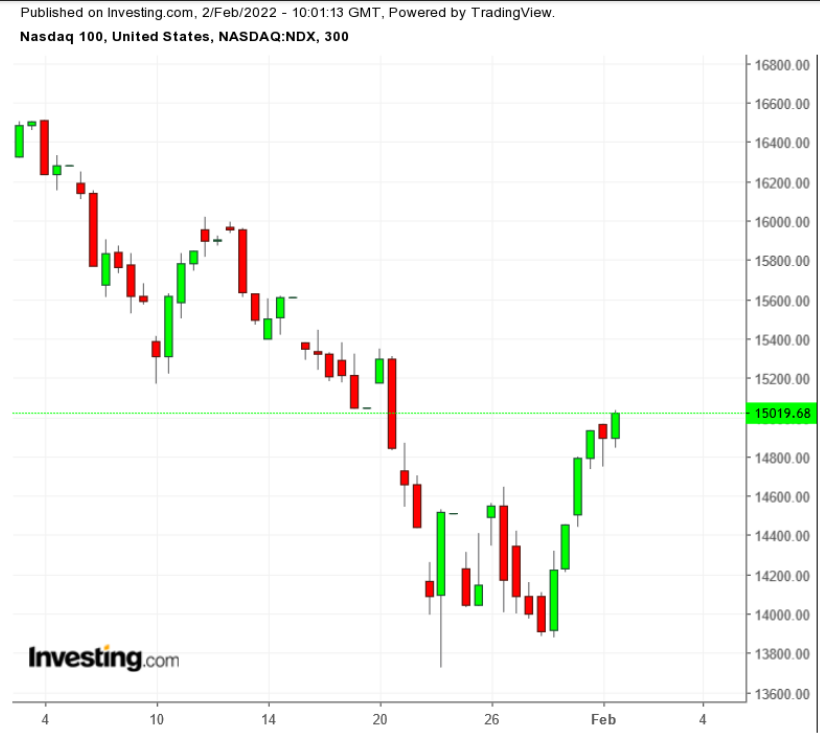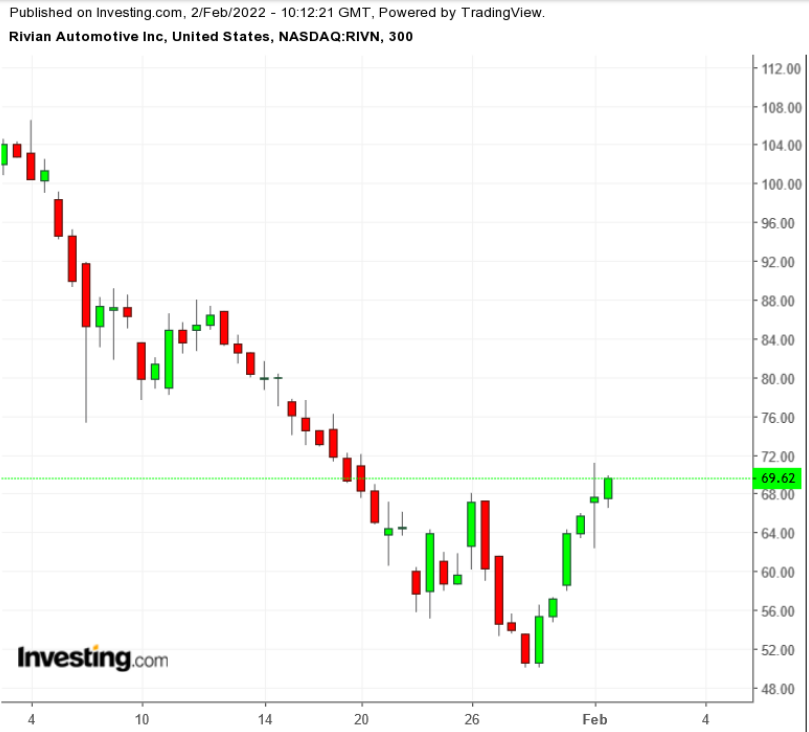Intel closes 23% higher after Nvidia takes $5B stake
The lumbering giant known as the US Federal Reserve is awake and worried. It's concerned about the inflation triggered by the COVID-19 pandemic and its effects on energy prices and global supply chains. US YoY CPI was 7% in December.
So, for 2022 for sure, investors must pay attention to what the Fed does—which for now at least means pushing interest rates higher for the first time in two years after the central bank cut its key federal funds rate basically to zero to help the economy survive the pandemic.
Smart investors will continue to keep an eye on the US central bank's moves longer term since the hiking process could have a variety of knock-on effects, though some have already begun even before the rate hikes have started. Many investors seemed sucker-punched when Fed Chairman Jerome Powell said on Jan. 26 that the first interest-rate increase will probably come in March and the Fed would keep making moves until the inflation numbers came down.
Indeed, markets overall really began to focus on accelerating inflation in November 2021, right after a very frothy U.S. jobs report came out. Beginning on Nov. 8, a host of stock indices peaked, including the Russell 2000, the S&P Midcap 400, and the S&P 600 Small Cap Index. The largest cryptocurrency by market cap, Bitcoin, topped out at $68,925 on Nov. 10.
Still, the domestic economy overall has seemed to withstand the pandemic stresses. But there were side effects:
- Higher consumer prices, especially for food, cars, building materials and other staples. Plus, rising home prices.
- Oil prices pushing toward $90 a barrel and retail gas prices in some parts of the United States flirting with $4 a gallon.
- A feverish stock market, especially in 2020 and 2021, helped along by abnormally low interest rates.
But after a triumphant 2021 for equities, markets finally took a breather, with all major US indices tumbling in January 2022.

The NASDAQ Composite and NASDAQ 100 suffered their worst January losses since 2008. The S&P 500 and Dow Jones Industrial Average sustained their biggest monthly losses since February 2009.
However, beginning this past Friday, Jan. 28 and continuing into this week as the month came to a close, stocks enjoyed big rallies reversing losses seen in January. February opened with another strong rally, followed by robust earnings after hours on Tuesday from Alphabet (NASDAQ:GOOGL) and Advanced Micro Devices (NASDAQ:AMD) but less impressive results and guidance from PayPal (NASDAQ:PYPL), General Motors (NYSE:GM) and Starbucks (NASDAQ:SBUX).
Alphabet also announced a 20-for-1 stock split. Shares of the Google parent company jumped more than 10% in after hours trading.
Of course, it's still too early to know if these strong results will offset the impact of the Fed's upcoming moves. It could simply be that traders are now snapping up stocks that had become oversold, such as EV truck and SUV maker Rivian Automotive (NASDAQ:RIVN).

Shares of the Irvine, California-based auto manufacturer were up 15.1% on Monday and 5.9% on Tuesday. Those gains, however, came after a 36.6% tumble in January.
These rallies are also being fueled by good earnings reports from the biggest companies, including Apple (NASDAQ:AAPL) and Microsoft (NASDAQ:MSFT) last week.
And perhaps Wall Street senses a good jobs report this coming Friday will show decent job growth but less wage pressure.
For all the downward pressure, January did produce some winners:
Energy stocks. Their rise has been fueled by higher oil prices (up 15% in January after a 34% increase in 2021). Shares look like they'll remain higher in February.
That should happen even if tensions over Ukraine fade. The US rig count has jumped 150% from its 244 low in August 2020 to 610 last week, according to Baker Hughes, though that's still a long way off from this century's peak of 2031.
Halliburton (NYSE:HAL), Schlumberger (NYSE:SLB) and Occidental Petroleum (NYSE:OXY) were the top S&P 500 stocks in January. Exxon Mobil (NYSE:XOM) was up 24% for the month after a 48.5% gain in 2021. Chevron (NYSE:CVX), up 11.9%, was the top-performing stock for the month of January.
As well, the Energy Select Sector SPDR® Fund (NYSE:XLE) was up 19% in January and up 46% in 2021. Exxon represents about 24% of the ETF's holdings.
While financial stocks were flat in January, the group performance was better than just about every other S&P 500 sector. Many analysts believe financial institutions win when rates are higher, because it gives them more pricing power and better earnings.
Dividend payers. Starting in September 2021, S&P 500 companies that paid dividends outperformed non-dividend payers. In January, payers slipped 2.9%. Non-dividend payers fell 9.5%. The 6.58% spread between payers and non-payers was the biggest since 2004, according to Howard Silverblatt, Standard & Poor's' senior index analyst.
The month's worst performers included:
Pandemic-focused shares. Stocks that soared in response to the pandemic, such as Moderna (NASDAQ:MRNA), which develops COVID vaccines. Moderna has fallen back, in part because so many other companies have been developing anti-COVID immunizations. Another loser was streaming video giant Netflix (NASDAQ:NFLX), down nearly 30% on fears customer growth may be slowing.
Recently IPO'd stocks. Shares of companies that went public in the last two years, especially tech and healthcare companies in 2021 showing little or no profits. Lately, they've been pushed lower because they aren't profitable at all or aren't profitable enough. Spotify (NYSE:SPOT) fell 16.1% in January, after falling 25.6% in 2021. Most of the audio streaming service's declines came in the fall, well ahead of the current controversy the service is facing. Zoom Video Communications (NASDAQ:ZM) fell 16.1% in January after a 45% decline for all of 2021. It went public in 2019.
Small biotechs. Mostly these companies go public to raise awareness of their research and to hopefully attract a partner with deeper pockets who could finance their work. Many are trading at 50% or less of their 52-week highs. The NASDAQ Biotechnology Index dropped 11.9% for the month.
How Many Hikes?
For investors, knowing that hikes are on the horizon, the key question now is, how fast will the Fed raise rates this year?
Until recently consensus had it at two or three times. Current chatter says that because inflation numbers are lousy, it's four times or more this year. Banking giant Goldman Sachs sees five rate increases in 2022. Ethan Harris, head of global economic research at Bank of America thinks it will be seven.
If Harris is right, and assuming each increase is a quarter percentage point, the federal funds rate could hit 2% by year-end. And the Fed may decide to continue pushing rates higher in 2023.
The initial rate increases may not have much effect on spending, home buying, consumer prices. It takes time for rate increase to work their way through an economy. Stocks could continue to rise, though many analysts see continued volatility.
But a series of rate increases will boost the cost of mortgages, auto loans, business inventories like cars. And if the Fed is too aggressive and overshoots its goals, the result could be economic stress.
Consider what happened in June 2003 when the economy gained steam as it recovered from the 9/11 terrorist attacks and the 2000-2001 dot.com bust. The Fed pushed the fed funds rate up from 1% to 5.25% in June 2006.
That would suggest a 30-year mortgage rate of 8%, not to mention higher consumer and business loan rates.
A year later, even as the S&P 500 was hitting record highs, it became clear that a 5.25% funds rate was causing stress on Wall Street and Main Street. The rate increases led to ballooning home foreclosures and revealed the shaky financial positions of a host of banks and financial institutions in the United States and abroad.
Result: the worst financial crisis since the Great Depression.
The shaky January market action notwithstanding, it may be just fine to continue buying stocks or equity funds. Big companies with big cash flows will still reward investors. Supply chain problems should ease. One hopes that global tensions will abate as well.
But as you invest, keep an eye on the Fed. Watch the pace of rate increases and stick with disciplined selling points.
